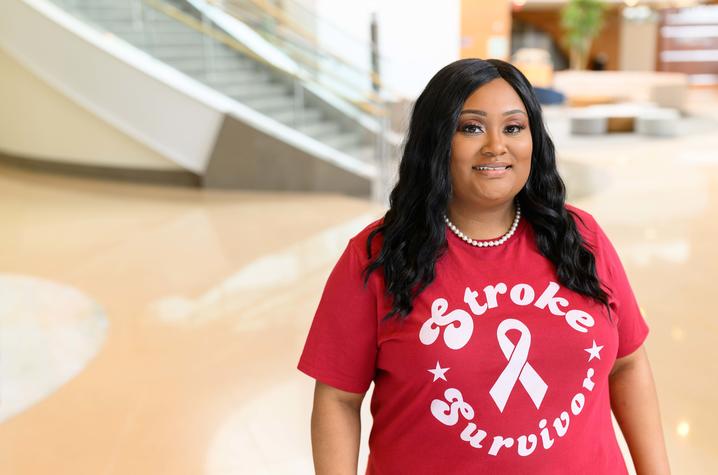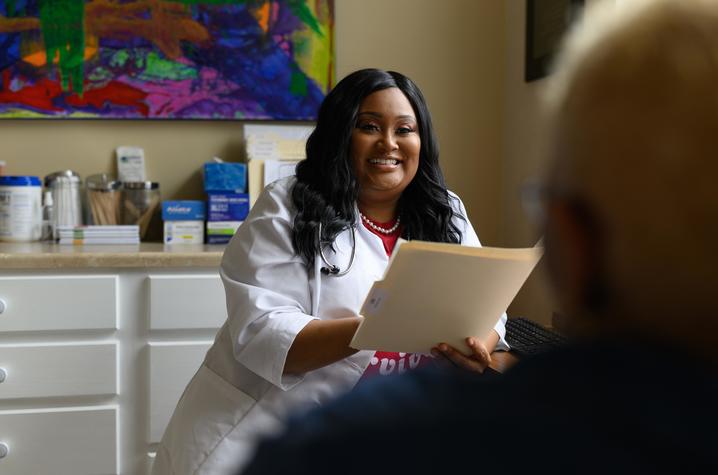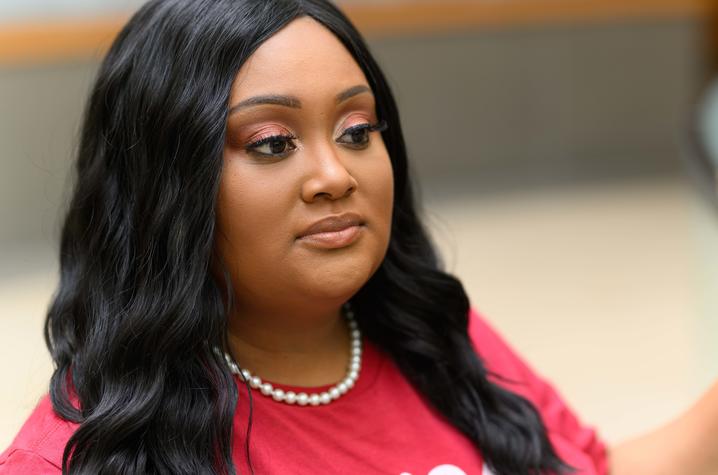UK HealthCare Helps Young Mom Overcome Heart Attack, Stroke
LEXINGTON, Ky. (July 14, 2022) — In her 37 years of life, DeShayna Davis has experienced two open-heart surgeries, a heart attack, multiple blood clots and a stroke. And that’s just the short list of what all she has endured.
In that time, she also went to school, leading to a meaningful career as a nurse and nurse practitioner. She now runs her own primary care practice known as Heart Rescue CPR. However, she says her biggest accomplishment to date during all that has transpired is being a mom.
“My girls are everything. I have two little people who depend on me,” said Davis. “I do not have a choice to not be okay.”
*****
Davis underwent her first open-heart surgery at 4 years old after being born with an atrial septal defect, a type of congenital heart defect. An atrial septal defect is a hole in the wall that divides the upper chambers of the heart. A hole can vary in size and may close on its own or may require surgery.
“They repaired my heart valve, but we always knew around the age of 30 I would likely need to have another surgery,” said Davis.
In the time leading up to that 30-year mark, Davis was leading an active life and doing well. In fact, she was doing well enough to give birth to her two daughters, both born prematurely but otherwise healthy.
On Jan. 31, 2014, at the age of 29, the young mother of two suffered a heart attack and went into ventricular fibrillation (known as V-fib). Davis remembers being in Nicholasville picking up some last-minute items before they headed out of town for the weekend for her oldest daughter’s gymnastics competition.
“I remember telling someone my chest was hurting but that it was okay, that I’m a nurse and I just have a lot going on right now,” said Davis. “Then I passed out.”
Thankfully there just happened to be a police officer nearby who was trained in CPR. After the officer and others provided lifesaving measures, Davis ended up at University of Kentucky Albert B. Chandler Hospital, where she was employed as a nurse at the time.
“They all knew me and were taking very good care of me, despite me being a little rowdy while I was intubated and sedated,” said Davis.
“This is a very young age for someone to have a heart attack,” said Paula Anaya, M.D., Ph.D., professor of medicine and director of inpatient cardiology at UK HealthCare’s Gill Heart & Vascular Institute. “Young women are generally not considered to be at high risk for cardiovascular disease until after menopause unless other risk factors are present such as diabetes, hypertension, hypercholesterolemia, or a strong family history of premature coronary artery disease.”
Anaya says for Davis, who has been his patient for the last eight years, the heart attack was likely caused by a thromboembolism, a blood clot that breaks off from an area of the body and blocks a blood vessel.
“A very small blood clot may have found its way to the systemic circulation and ended up in the distal portion of the left anterior descending coronary artery, causing her infarction,” Anaya said.
Doctors say it is possible that the atrial septal defect she was born with did contribute to this happening, which would help explain how it occurred at such a young age.
*****
As Davis recovered from her heart attack, doctors then diagnosed her with heart failure.
“The left bottom part of my heart, the left ventricle, doesn’t pump correctly. It is not in sync with the rest of my heart, which has contributed to heart failure,” she said. Over time, Davis developed a significant leak of her mitral valve.
Doctors continued to monitor Davis for a couple of years, and in 2017 her heart was strong enough to undergo a second surgery to repair her valve once again. The surgery — which took place outside of UK — took several hours, required Davis going on and off a bypass machine, and resulted in her having a temporary pacemaker. About a week later the temporary pacemaker was replaced with a permanent one due to a complete heart block.
With a new pacemaker and a new mechanical heart valve, Davis was ready to get back to her active lifestyle, but instead found herself getting winded easily. After a series of tests, it was determined her new mechanical valve was not closed all the way and was causing some regurgitation. Davis was just 32 years old, and had been told that she wouldn’t need another surgery for at least 20 years.
“My team of doctors at UK thought I might need another open-heart surgery to fix this. However, I did not want another surgery, especially since they were very concerned about operating a third time,” Davis said. “It was the last resort.”
Anaya wanted to explore every possible option for Davis that could prevent another open-heart surgery, which is why he sent her to John Gurley, M.D., director of the structural heart program in UK HealthCare’s Gill Heart & Vascular Institute. Gurley determined they could go in using a heart catheter and close the paravalvular leak. That was successful, and Davis was back to being able to exercise and do things like going up a flight of stairs without getting winded.
“The way this case was handled demonstrates the kind of collaborative work across disciplines that occurs every day within UK and between other institutions,” said Anaya.
After four years of doing relatively well with her health, Davis was then diagnosed with peripheral arterial disease (PAD) after experiencing pain and strange feelings in her right foot and right calf. Peripheral arterial disease in the legs or lower extremities is the narrowing or blockage of the vessels that carry blood from the heart to the legs.
Within her first year of managing and living with her latest diagnosis of PAD, Davis experienced a blood clot in her left leg on Nov. 13, 2021, which required emergency surgery. Just a few weeks later, she contracted COVID-19. All of this just added to her growing list of health scares.
“It’s just a lot,” said Davis, who by then was just 37 years old. “From being born with a congenital heart defect, having two kids prematurely because my heart couldn’t handle a full-term pregnancy, having a mini stroke, having a heart attack and heart failure, another heart surgery to fix the valve, and then a blood clot and COVID.”
Little did she know another major medical event was just around the corner.
*****
On Jan. 20, 2022, Davis was out for the evening with some friends when she noticed her right hand felt strange.
“It started feeling weak, and I couldn’t hold it up,” said Davis.
She then remembers heading to the restroom feeling a bit wobbly and decided to leave the door unlocked in case something happened. After washing her hands Davis says she fell backwards onto the floor. About 10 minutes later, her friends found her.
“They were trying to get me to respond — I was there physically, but I couldn’t respond.,” she said. “I knew what was going on, and people were trying to get me to do stuff like squeeze their hand or speak but I couldn’t.”
Her friends recognized the signs of a potential stroke and called 911. Paramedics then rushed Davis to UK Chandler Hospital.
“She was not getting nearly enough blood flow to her brain, and it was not allowing her speech center to function normally,” said David Dornbos III, M.D., UK HealthCare’s Kentucky Neuroscience Institute. “We discovered her stroke was due to a large blood clot in a major vessel supplying the left side of the brain, which her severe heart problems do put her at risk for.”
Davis remembers being in the emergency department, aware of what was going on around her but unable to communicate.
“I was thinking, ‘Okay, I’ve been through this kind of thing before, they are going to put me in for a CT scan, and then I will go back to a room and wait for the results,’” said Davis. “The next thing I know I’m in a suite and I’m thinking, ‘Hey this looks like a surgical suite.’”
The single mother then began to worry about undergoing surgery with none of her family knowing she was in the hospital.
“I need to see my family and my girls before I go back … that’s all I’m thinking. I told them I don’t know what you have to do but somehow, I need to talk to my daughters before I go back,” said Davis. “They explained that I was having a stroke and time was ticking, which I understood, but I need to see my family because I don’t want them to just know I had a surgery and never came back.”
After Davis was able to see her mother and talk with both of her daughters, she underwent an emergent thrombectomy by Dornbos.
“We do a thrombectomy for anyone that has a large blood clot that is blocking blood flow to the brain. We go in with catheters through the wrist and track them inside the blood vessels of the arm, neck, and then into the brain,” said Dornbos. “We then use those catheters to suck out the blood clot. Once the blood clot is out, normal blood flow to the brain is restored. It is always a race to get normal blood flow back before the stroke changes become permanent.”
The thrombectomy was successful, and the effects from the stroke subsided. Dornbos says the ultimate joy from his job comes from watching patients like Davis get back to normal.
“If I didn’t have my girls, all of this wouldn’t be as big of a deal, but I have to be okay,” said Davis.
*****
In May, Davis watched her oldest daughter graduate high school. Her two daughters, now 17 and 13 years old, are the light of her life. They are the motivation behind pretty much all she does.
“I actually started Heart Rescue CPR after my heart attack a few years ago,” she said. “I remember my youngest daughter asking why I wasn’t able to take her to her gymnastics meet at that time — she was still so young.”
It was questions like that, and her daughters wondering if they would know what to do if their mom suffered another heart attack, that led Davis to start her own practice.
“I wanted to start Heart Rescue CPR to provide emergency first aid and CPR training for the community,” Davis said. “Nurses and other health care workers are required to maintain their CPR certification every two years, and I train these professionals all the time. But I really wanted to focus on being able to train bystanders and people like my kids. I’ve had the chance to train a lot of kids through the high schools and other programs.”
While living through all her health issues, Davis also was busy earning her nursing degree as a family nurse practitioner (FNP) and licensed advanced practice registered nurse (APRN). After more than a dozen years of experience in health care, Davis decided to also use her new venture to provide medical services through establishing her own clinic. Additionally, she fills her time volunteering at Mission Health Lexington, a charitable medical clinic, after recognizing the health disparities seen among uninsured and underinsured patients in Kentucky.
In these roles, Davis says she can connect with her patients thanks to all she has endured firsthand.
“I have been through so much medically in my life, and many times I never understood why things always happened to me,” she said. “But through my experiences, I have learned to empathize more with my patients and have become the best advocate for their health and well-being.”
*****
Davis has always had a fighting spirit — from the time she was a little girl undergoing open-heart surgery up until today — that spirit was enhanced when she became a mom. That is something all of her doctors know.
“I love the communication and collaboration with all the providers. They let me go sit down and talk with various specialists, from UK and outside of UK, and then we all come back together to make a plan,” said Davis. “They always make sure that I’m comfortable with the situation, they draw pictures for me, they explain stuff to my mom who always has questions.”
All her doctors are thrilled to see Davis enjoying a full life and say much of that is to her credit as she has continued to flourish and overcome challenges.
Anaya says Davis has benefited from the resources and expertise residing at UK HealthCare and the Gill Heart & Vascular Institute, including the availability of advanced cardiovascular imaging capabilities, state-of-the-art treatments from interventional cardiologists and a compassionate, skilled nursing staff.
“She is a fighter through and through,” said Anaya. “As a former UK nurse herself, she understands well the hard work that goes into the management of complex cases at UK, and she has always been appreciative of that.”
It is through that firsthand experience in health care that Davis knows she is in good hands whenever a need arises, and she is forever grateful for the care she has received and will continue to receive.
“You don’t want to go into a procedure and not wake up again, because I have so much on my plate. My girls depend on me,” said Davis. “Thanks to the care I’ve received, day to day I see myself just as a regular person … but I do joke that my heart seems to have a mind of its own.”
As the state’s flagship, land-grant institution, the University of Kentucky exists to advance the Commonwealth. We do that by preparing the next generation of leaders — placing students at the heart of everything we do — and transforming the lives of Kentuckians through education, research and creative work, service and health care. We pride ourselves on being a catalyst for breakthroughs and a force for healing, a place where ingenuity unfolds. It's all made possible by our people — visionaries, disruptors and pioneers — who make up 200 academic programs, a $476.5 million research and development enterprise and a world-class medical center, all on one campus.







